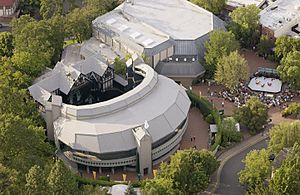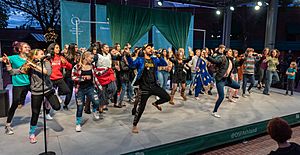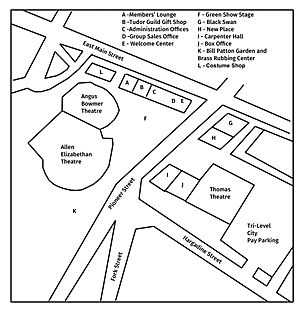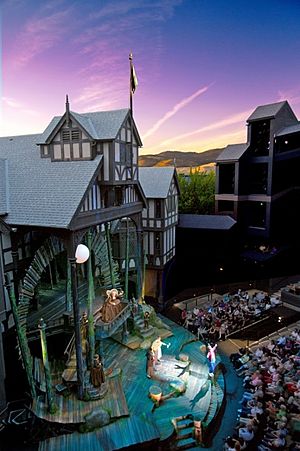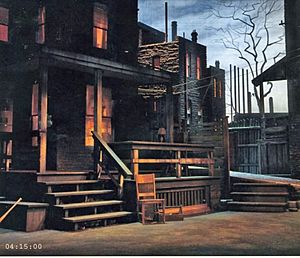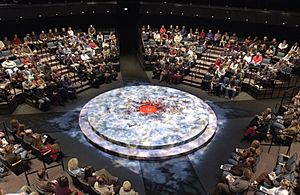Oregon Shakespeare Festival facts for kids
Quick facts for kids Oregon Shakespeare Festival |
|
|---|---|

Angus Bowmer and the outdoor theatre, the keystone of the Oregon Shakespeare Festival he created.
|
|
| Genre | Repertory theatre |
| Begins | Each April |
| Ends | Each December |
| Frequency | annual |
| Location(s) | Ashland, Oregon |
| Inaugurated | 1935 |
| Attendance | 400,000 (annual) |
| Budget | $32 million (annual) |
| Website | www.osfashland.org |
The Oregon Shakespeare Festival (OSF) is a famous theatre company in Ashland, Oregon, USA. It was started in 1935 by Angus L. Bowmer. The Festival performs many different plays, not just Shakespeare's. They show classic and modern plays.
Each year, between five and eleven plays are performed daily. These shows happen six days a week in the Festival's three theatres. The Festival welcomed its one millionth visitor in 1971. By 2015, it had welcomed 20 million visitors!
Contents
About the Festival
The Oregon Shakespeare Festival (OSF) is a special theatre company. It is known for performing many different plays. These plays are shown from late April through December each year. The Festival puts on 800 to 850 shows. Nearly 400,000 people come to watch these plays every year.
The Festival performs plays by Shakespeare and other famous writers. They also show new plays by modern writers. Each year, two or three plays are performed in the outdoor Allen Elizabethan Theatre. Two or three plays are in the smaller Thomas Theatre. Four or five plays are in the traditional Angus Bowmer Theatre.
OSF has performed all 37 of Shakespeare's plays four times. This happened in 1958, 1978, 1997, and 2016. Since 1960, they have also shown plays not written by Shakespeare. Since 2000, at least one new play has been shown each season. Many of these new plays have won awards. The Festival also has many learning programs. These programs are for students, teachers, and theatre professionals.
Festival History
In 1893, people in Ashland built a place for special events called Chautauqua. This building could hold 1,500 people. Famous people like John Philip Sousa performed there.
By the 1920s, the Chautauqua building was falling apart. In 1935, Angus L. Bowmer, a drama professor, had an idea. He noticed the building's walls looked like old English theatres. He suggested using it to perform Shakespeare's plays. The city of Ashland loaned him a small amount of money. They also asked him to add boxing matches to help make money.
Bowmer agreed and presented Twelfth Night and The Merchant of Venice. He directed and acted in both plays. The plays made enough money to cover the boxing matches' losses!
The Festival has continued almost every year since then. It stopped only during World War II (1941–1946) and for most of 2020 and 2021 due to the COVID-19 pandemic. The Festival quickly became known for its excellent shows. In 1939, OSF took a play to San Francisco. It was even broadcast on national radio!
From 1951 to 1973, NBC broadcast shorter versions of the plays. These broadcasts were heard by millions across the country. This helped the Festival become very famous. In 1957, Life magazine wrote a story about it. This brought even more people to Ashland.
Angus L. Bowmer retired in 1971. Jerry Turner took over. He added plays by other famous writers like Molière. Later, Libby Appel became Artistic Director from 1996 to 2007. Bill Rauch followed her from 2008 to 2019. He added musicals and plays from different cultures. He also started a program to create new American plays.
In 2019, Nataki Garrett became the new artistic director. In 2023, she resigned, and Tim Bond became the new artistic director.
Many famous people have visited the Festival. Bing Crosby was an honorary director. Charles Laughton visited in 1961 and loved the plays. Stacy Keach was an actor there in the early 1960s.
Festival Traditions
Since 1952, a special tradition happens after the last outdoor play of the season. All the company members, carrying candles, walk into the dark theatre. They listen to the old English song "Greensleeves." One person speaks lines from Shakespeare's play The Tempest. Then, everyone puts out their candles and leaves quietly.
Another tradition is the Feast of Will. It started in 1956 in Lithia Park. This event opens the outdoor season.
Festival Growth
In the late 1970s, the city of Portland asked OSF to start a theatre there. This led to the creation of Portland Center Stage in 1988. It became its own theatre company in 1994.
In 1970, the indoor Angus Bowmer Theatre opened. This allowed the Festival to have shows in spring and fall. Attendance quickly tripled to 150,000 people a year. By 1977, a third theatre, the Black Swan, opened. Attendance reached 300,000. By 1979, the Festival was showing 11 plays each season.
In 1983, OSF won a Tony Award for its great work in regional theatre. In 1988, the Festival changed its name to the Oregon Shakespeare Festival.
In 2002, the Thomas Theatre replaced the Black Swan. It is used for smaller, more experimental plays. In 2003, Time magazine named OSF the second-best regional theatre in the USA.
The 2020 season had to close early because of the COVID-19 pandemic. The Festival returned with live shows in 2022. In April 2023, OSF faced financial problems. They needed to raise money to keep the season going. They successfully raised the money by June.
You can find a full list of all OSF plays in another article: Production history of the Oregon Shakespeare Festival.
Green Show
Before the evening plays, a free outdoor "Green Show" takes place. It has been happening since 1951. Hundreds of people, even those not seeing a play, come to watch. These shows happen from June through September, Wednesday through Saturday nights.
The Green Show used to feature old English music and dancers. Since 2008, the shows have become very diverse. You might see a dance group from Mexico or India. There could be clowns, magicians, or musicians playing different styles of music. They even do rock-n-roll versions of Shakespeare!
Economic Impact
The Oregon Shakespeare Festival is very important to Ashland's economy. Ashland is a small town with only about 20,000 people. The Festival brings in many visitors who buy tickets. They also spend money at restaurants, hotels, and shops in Ashland.
This spending creates a "multiplier effect." This means that each dollar spent at the Festival leads to more spending in the town. This helps the local businesses and creates jobs.
| Year | 2013 | 2015 | 2018 |
|---|---|---|---|
| Plays performed | n/a | 786 | 811 |
| Tickets sold | 407,787 | 390,380 | 362,838 |
| Individual patrons | 108,388 | 103,380 | 123,074 |
| Average plays per patron | 3.76 | 3.76 | 2.94 |
| Direct expenditures | $86,768,108 | $90,515,710 | $89,773,545 |
| Multiplier effect | $251,627,515 | $262,495,559 | $260,244,545 |
The Festival also helps the community in other ways. It takes part in local celebrations like Martin Luther King Day and the Fourth of July Parade. The Green Show is free for everyone. The Daedalus Project is a fundraiser run by company members. It has supported charities since 1987.
In 2016, the Festival hosted a big Asian American Theater Conference. This event included new plays and Green Shows.
Festival Campus
The Oregon Shakespeare Festival is on a 4-acre campus. It is next to Lithia Park in Ashland. The main buildings are the three theatres. There are also Carpenter Hall, and the Camps, Pioneer, and Administration buildings. All these buildings are around a central open area called "The Bricks." This area is used for the nightly Green Shows.
Other buildings off-campus include a production facility, classrooms, and costume storage.
Allen Elizabethan Theatre
The Allen Elizabethan Theatre is the outdoor theatre. It has changed a lot since the Festival started in 1935.
First Outdoor Theatre
The first outdoor theatre was designed by Angus L. Bowmer. It was built inside the old Chautauqua building walls. Bowmer designed a stage that stuck out into the audience. It had a balcony and columns. Actors also worked as stage hands. The lighting was made from coffee cans! This theatre was taken down during World War II.
Second Outdoor Theatre
A second outdoor theatre was built in 1947. It had a different stage shape and better seating. More backstage areas were added over time. But it became unsafe and was torn down in 1958.
Current Allen Elizabethan Theatre
The current outdoor theatre opened in 1959. It was renamed the Allen Elizabethan Theatre in 2013. It was designed to look like London's 1599 Fortune Theatre. The stage has many different areas for actors to perform.
Before each show, an actor opens a window in the roof. They raise a flag to the sound of a trumpet. This signals that a play is about to begin, just like in old Elizabethan times.
The theatre has 1,200 seats. They are arranged in curves up a hillside. This gives everyone a great view of the stage. The old Chautauqua theatre walls, now covered in ivy, are still the outer walls of the theatre.
In 1992, the $7.6 million Paul Allen Pavilion was added. It has a control room and services for the audience. You can rent hearing devices, blankets, and pillows. Food and drinks are allowed inside.
Angus Bowmer Theatre
In 1968, a report showed that OSF was turning away many people. It also showed that the Festival was important for southern Oregon's economy. This led to the idea of building an indoor theatre. The city of Ashland got a grant for the project. Private donations also helped raise money. Construction began in December 1969.
The theatre opened just five months later in 1970. The first play was Rosencrantz and Guildenstern Are Dead. This showed that the Festival was ready to perform modern plays too. The Angus Bowmer Theatre can seat between 592 and 610 people. It more than doubled the audience capacity. It also allowed shows to happen in spring and fall.
The theatre's design is very flexible. All seats are close to the stage. The stage can change its shape. It can be a thrust stage, like the outdoor theatre. It can also be a traditional stage or even drop down to create an orchestra pit. The walls of the auditorium can move to change the playing area.
These pictures show how quickly the stage can change. The first is for Fences. The second, taken just two hours later, is for The Clay Cart. This shows how true repertory theatre works. Stage crews must change sets quickly between shows. Actors must be able to play different roles in different plays on the same day.
In 2011, a crack was found in the theatre's main support beam. Shows had to be moved to other places. A temporary tent theatre was set up in Lithia Park. The theatre reopened a month later.
Black Swan
The Black Swan was the Festival's third theatre from 1977 to 2001. The building was originally a car dealership. It was bought in 1969 to be a scene shop and rehearsal hall. Actors started using it for late-night readings. The Artistic Director saw a chance to try new and different plays there.
The Black Swan was small, with only 138 seats. It was challenging to fit a theatre into the existing building. Directors had to work around a support beam in the middle of the stage. In 2002, it was replaced by the New Theatre (now Thomas Theatre). The Black Swan now serves as a rehearsal space and home for the Black Swan Lab.
Thomas Theatre
The Thomas Theatre opened in 2002. It was designed to be more flexible and hold more people than the Black Swan. It was renamed in 2013 to honor Peter Thomas, a longtime OSF development director. The theatre allows for new and creative productions. No seat is more than six rows from the stage, keeping it intimate.
The seats can be arranged in three ways. In "arena mode," the stage is surrounded by 360 seats. In "three-quarter thrust mode," 270 seats surround the stage on three sides. In "avenue mode," 228 seats are on two sides of the stage. The building also has lobbies, dressing rooms, and storage areas.
Other Buildings
The Box Office is on the same courtyard as the Thomas Theatre. The Administration Building holds many offices, like artistic, business, and human resources. The Camps Building has a lounge for members and marketing offices.
The Festival's costume shop is in the Pioneer Building. Staff create costumes and accessories there. They also have a wig shop.
Carpenter Hall is used for lectures, concerts, and rehearsals. The Bill Patton Garden hosts free talks by OSF actors in the summer. The Tudor Guild Gift Shop sells merchandise. The Festival also has a fitness center for actors.
In 2013, a large Production Building opened in Talent, Oregon. This building has modern facilities for building sets and props. It also houses OSF's costume warehouse. They have over 50,000 costumes and 15,000 props available to rent!
The old scene shop was turned into the Hay-Patton Rehearsal Center. It opened in 2015. It has six rehearsal halls with special floors to prevent injuries. These halls can be set up to look exactly like the stages in the three theatres. The building also has offices, recording studios, and green rooms for actors.
How OSF is Organized
OSF is a non-profit organization. It is managed by a Board of Directors. The Festival also has an endowment, which is a fund that helps support its yearly costs.
OSF offers different ways for people to support the Festival. In 2022, they started a "Change Makers" donor program. Ticket prices were also lowered to make shows more accessible.
Staff and Programs
The Festival has a paid staff organized into different sections. These include artistic, production, education, and administration.
The Artistic Director chooses the plays and directors for each season. They also select the 70-120 actors, musicians, and dancers. Nataki Garrett was the Artistic Director from 2019 to 2023. She is known for helping to create new plays. Tim Bond became the new Artistic Director in July 2023.
The voice and text staff help actors with their voices and lines. Intimacy Directors ensure actors feel safe during emotional scenes.
OSF has many educational programs. "Shakespeare in the Classroom" helps teachers make Shakespeare fun for students. The School Visit Program sends actors to schools in different states. They perform short plays and lead workshops.
A partnership with Ashland High School helps students learn about theatre. The Festival also offers programs for adults. These include talks, seminars, and even tours to places like England and Greece.
The Administrative staff manages the buildings, accounting, and IT. The Marketing and Communications team handles tickets, audience services, and publications. The Human Resources team manages employees and volunteers. They also have programs for students who want to work in theatre.
Archives
OSF has a special archive. It collects and keeps documents, photos, recordings, and items from the Festival's history. This helps preserve the memory of the plays and events.
In 2013, the Festival received a grant to digitize old tapes and films. This means they can be viewed online. The collection includes recordings of over 500 plays from 1950 to 2012. It also has interviews with artists, lectures, and even home movies from the founder, Angus Bowmer!
Volunteers
About 700 volunteers help the Festival each year. They contribute thousands of hours. Volunteers help visitors on campus and at the Welcome Center. They also work as ushers and ticket takers in the theatres.
Behind the scenes, volunteers help in the archives, costume shop, and offices. They assist with auditions, drive company vehicles, and help with events.
Local clubs also help. Soroptimists provide blankets and cushions for the outdoor theatre. Tudor Guild volunteers work in the gift shop. Ashland Garden Club members create flower arrangements for the Feast of Will.
Each November, the Festival hosts a party to thank its volunteers.
Publications
All playgoers receive a free Playbill. It has information about the plays, actors, and directors. Each year, the Festival publishes guides for school groups and adult groups.
They also used to publish an annual Souvenir Program. This program had photos of the plays and stories about the actors and staff. A "Bard Scorecard" helps playgoers keep track of which Shakespeare plays they have seen.
Professional Groups
OSF is part of important theatre organizations. These include Theatre Communications Group and the Shakespeare Theatre Association of America. It also works with unions for actors, stage managers, and directors.
Images for kids


